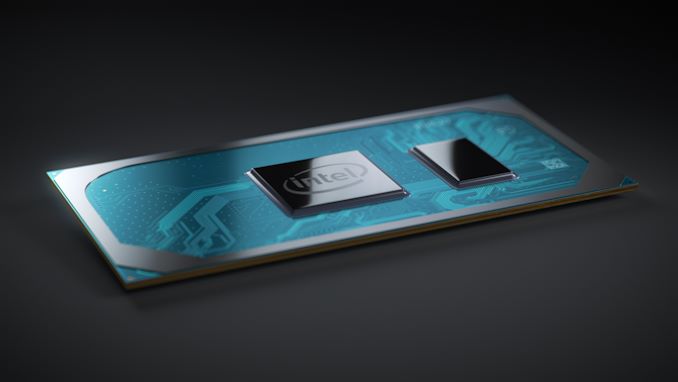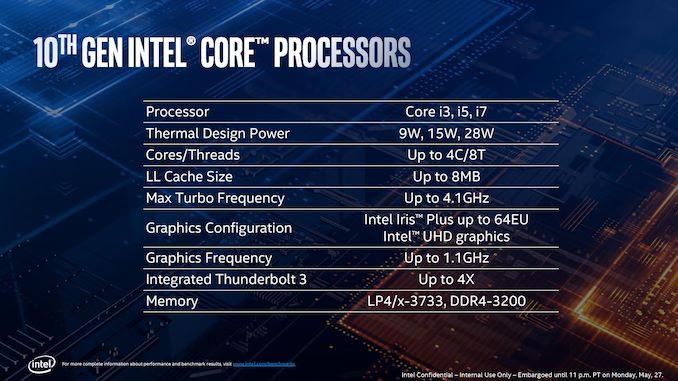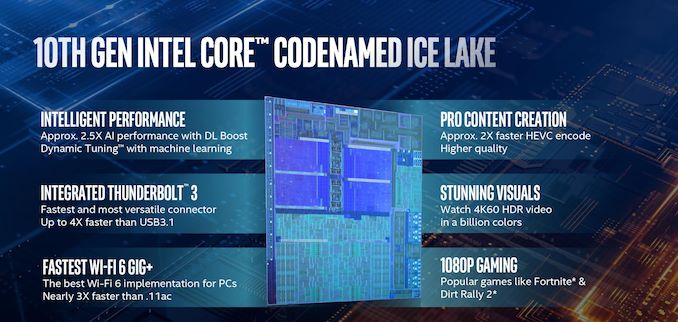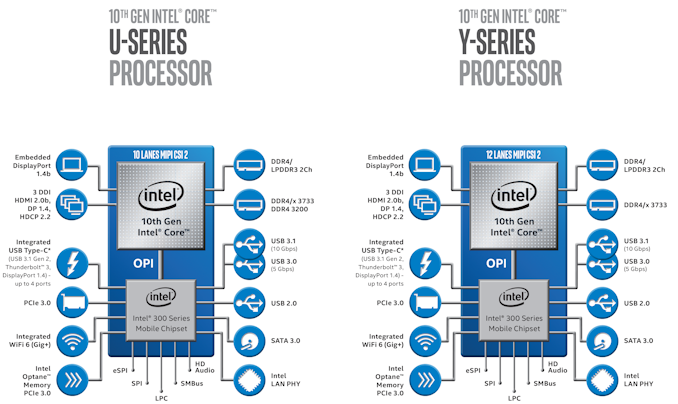Intel Begins Commercial Shipments of 10nm Ice Lake CPUs to OEMs
by Anton Shilov on July 26, 2019 5:30 PM EST
Intel has begun shipments of its 10th generation Core "Ice Lake" processors as of the second quarter, according to the company in an earnings call this week. Made using Intel’s 10nm process technology, these laptop CPUs were qualified by OEMs earlier in 2019 and are on track to reach the market inside mobile PCs by the holiday season.
As reported, Intel began to produce Ice Lake processors in the first quarter in a bid to build up inventory to support a high-volume launch in the second half of the year. The processors passed qualification by PC makers in Q1 – Q2, and then Intel started to ship them for revenue later in the quarter, which was a little bit earlier than anticipated by various market observers. Keeping in mind the lead-time required to get assembled PCs on to store shelves, Ice Lake-powered PCs are well on track to hit the market in Q4 with some machines possibly reaching retailers earlier than that.
Bob Swan, CEO of Intel, stated the following:
- “We began shipping Ice Lake client [CPUs] in the second quarter supporting systems on the shelf for the holiday selling season.”
Intel formally introduced its laptop-focused Ice Lake-U and Ice Lake-Y CPUs, which are based on the Sunny Cove microarchitecture, in late May. Officially called ‘Intel 10th Generation Core’ processors, the family includes 11 chips (ranging from Core i3 to Core i7) featuring two or four general-purpose CPU cores as well as various GPU configurations and coming to market with 9W, 15W, and 28W TDP variants.
On the CPU side of things, Intel promises an average 18% raw clock-for-clock performance uplift compared to the Skylake core released in 2016 (which has been used with small tweaks since then) along with VNNI and Cryptographic ISA instructions. On the GPU side of matters, Ice Lake CPUs will integrate Intel’s Gen11 graphics core with up to 64 execution units, with Intel promising significant performance improvements as well. The updated iGPU will also natively support DisplayPort 1.4 and HDMI 2.0b outputs as well as HDCP 2.2 technology.
As is traditional for Intel’s lower-power mobile parts, the new Ice Lake processors will come with on-package chipsets. The new 300-series chipsets for ICL will natively support USB 3.1 Gen 2, Wi-Fi 6 MAC (RF module will be sold separately), PCIe 3.0, and other features.
Overall, Intel’s road to high-volume production of 10nm CPUs has been long and bumpy; but it looks like the company is finally turning a corner in time for their Q4 launch.
Related Reading:
- Intel Unveils 10th Gen Core Ice Lake-U & Ice Lake-Y Mobile CPUs: 10nm Sunny Cove Later This Year
- Intel Starts Qualification of Ice Lake CPUs, Raises 10nm Volume Expectation for 2019
- Intel Teases Ice Lake-U Integrated Graphics Performance
Source: Intel













115 Comments
View All Comments
AlyxSharkBite - Friday, July 26, 2019 - link
Totally irrelevant when the PC Gaming Market makes more money than the Hollywood Movie. (Not counting consoles) yep totally irrelevant. But please do tell me more.azfacea - Friday, July 26, 2019 - link
the last guy that thought desktop was irrelevant was IBM wonder what happened to themJorgp2 - Saturday, July 27, 2019 - link
https://www.marketwatch.com/investing/stock/ibmI don't know, you tell me
willis936 - Saturday, July 27, 2019 - link
I couldn't figure out how to get that site to show history back to the 80s, since that's when they lost to compaq and intel. They had the entire market. Can you imagine if there was a microsoft of hardware today? Some stock figures from their business machines tucked away in a warehouse say nothing of what they lost due to hubris.willis936 - Saturday, July 27, 2019 - link
Whoops just found it. They are worth more now than they were in the 80s, but that doesn't say what they could be had they not dropped the entire PC market.Kevin G - Sunday, July 28, 2019 - link
If you want to play what-if like that, imagine if Intel had gotten the CPU contract for the iPhone and some what buckled to Apple's low margin, high volume demand for that market.Another fun what-if is AMD buying nVidia instead of ATI.
Intel still had several Netburst design waiting in the wings before there right turn at Core 2, so what if they continued down the Netburst path?
Last fun what-if: Intel was actually on time with Itanium and did manage to get vendors to push out 64 bit workstations/highend PC's and AMD still released their x86 extensions.
Lord of the Bored - Monday, July 29, 2019 - link
IBM didn't have the entire market in the 80s. Not minicomputers, not personal computers. There was very robust competition from an abundance of architectures. Even more if you include home computers instead of just business machines.That said, they did far better than many of their fellow old-guard computer companies because they insulated their personal computer division so the minicomputer division couldn't sabotage it. There's a world where we all use machines derived from DEC's PDP-11, TI's TI-990, or Data General Nova. To name but a few of the contenders that self-sabotaged. I think IBM is the only company with a minicomputer division that successfully made the transition to personal computers. Most that tried never shipped a micro, and those that did shipped horribly neutered machines at the demands of the minicomp divisions.
Santoval - Saturday, July 27, 2019 - link
Which is why AMD will release devices sporting Zen 2 based APUs by the year's holiday season as well. On the CPU core side Ice Lake-U/Y are going to be *barely* faster than the Whiskey/Amber Lake CPUs they are to replace. While they have a higher IPC (not 18% higher, that's over the original Skylake of 2015 - *not* 2016 btw) most of the IPC gains will be eaten away by their much lower clocks. The much lower clocks, in turn, are due to their 10nm+ node's atrocious yields.Extrapolating from the graph Intel released (they only compared Ice Lake-U 15W to ... Broadlake, in just one graph, in an obvious attempt to obfuscate the numbers) they are going to have a 3 or 4% higher single core performance, 15W for 15W. At best, and if the Sun always shines on them, a +5% performance tops. Unless they trimmed a lot of their "multi-core overhead", which I doubt, the multi-core performance gain will also be comparable, in the 3 - 5% range. If this was a mere refresh the performance gain would be fine, but since we are talking about both a new μarch and a new process node it is truly pitiful, which why Intel did their best to mask Ice Lake's CPU performance deficit in their Computex presentation (they masked it with iGPU, neural network and ..... wi-fi performance numbers, "forgetting" to talk about CPU numbers at all in their main presentation; they released them later to the press in an obfuscated form, almost as a footnote).
Nevertheless, despite their CPU deficiency, Ice Lake-U/Y will also sport a new iGPU, a new media engine with more codecs and higher resolution support, support for Optane memory, and native Thunderbolt 3. The new iGPU, in particular, is probably the most dangerous for AMD since until now they had a clear edge on that era. Intel will need to be quite aggressive in their iGPU deployment for that to pose any threat though, and not retain the 48 core and 64 core iGPUs just for the high end SKUs. I do not expect that to happen, with Intel still being Intel here. The 64-core iGPUs in particular will surely be super rare, just for 28W parts with eDRAM.
In any case AMD need fast and capable Zen 2 based APUs in order to compete. They will probably not exceed 15W TDPs either, so they will have a clear gain in power efficiency as well. Intel's "abnormal" TDPs are also due to their yield issues. Fanless devices with 9W Ice Lake-Y parts are probably still possible, but they will require quite sophisticated -and more expensive- passive cooling solutions.
Kevin G - Sunday, July 28, 2019 - link
Using Sky Lake as baseline is fine as they are still effectively on that micro-architecture. The biggest changes in over the past couple of years have been from an increase in shared L3 cache size (a side effect of higher core count) and the patching of security vulnerabilities.The real comparison is what the base clocks are vs. turbos.
Ice Lake does have lower turbos from the information that has leaked thus far but I have yet to hear much about base clock speeds, especially when under AVX or AVX-512 modes. This may not be as dire if Intel can keep up average clock speeds similar or higher than Coffee Lake and ride the IPC increase for the generational performance gain.
I would expect Optane DIMM support in the memory controller but I highly doubt that Intel would genuinely enable that in consumer systems. (Xeon E is a different question.)
The parts with eDRAM will likely find a home inside of MacBooks, like what happened with similar Sky Lake, Kaby Lake and Coffee Lake designs. The real radical was Kaby Lake-G with its Vega graphics as I am really shocked that that hasn't been picked up by Apple.
Gondalf - Sunday, July 28, 2019 - link
For now they have their present Ryzen Mobile 3000 line.There isn't news about APUs on 7nm right now but we can argue that the producty cycle is minimun one year, so we will not see 7nm APUs since Q1/Q2 next year.
Remember that Intel has Tiger Lake for 2020 with the far more efficient Xe ark on GPU, so AMD has to react fast to not lose the small market share in Laptops.